Succulent Plant Reproduction: A Comprehensive Guide
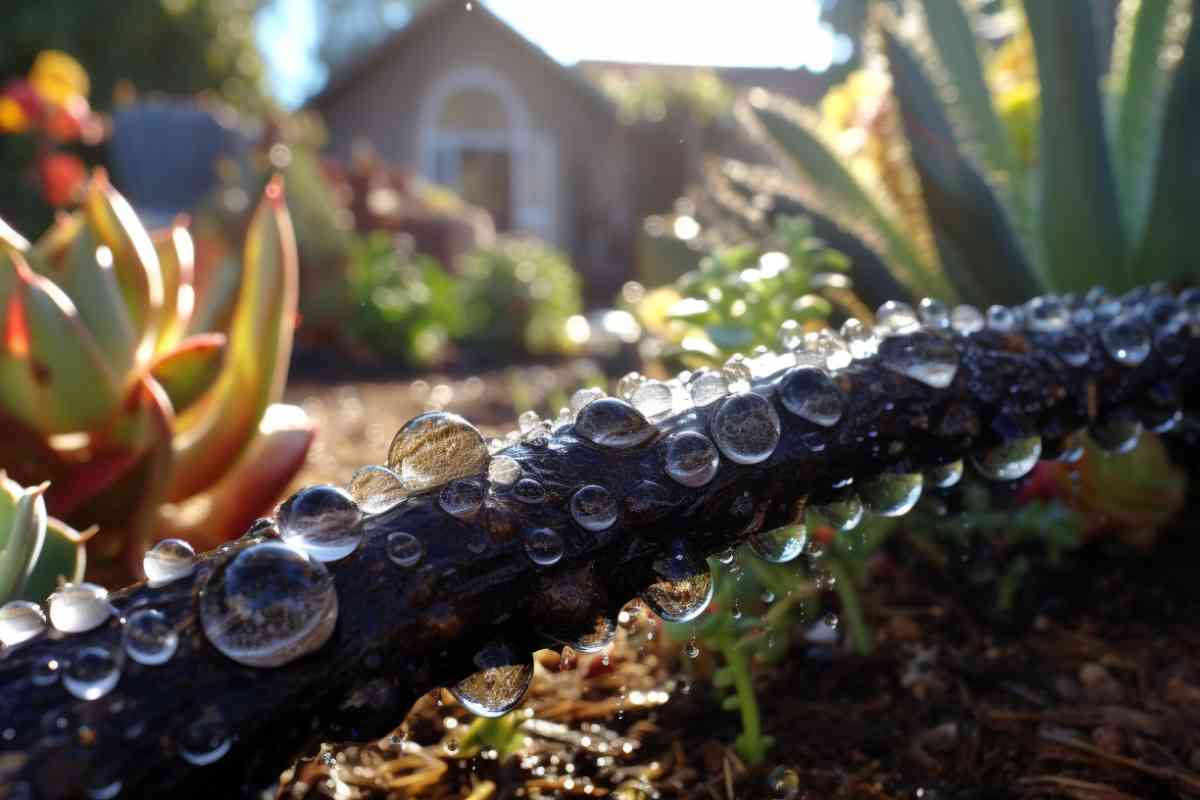
Succulent plants are both diverse and efficient when it comes to reproduction. Succulents are survivors, so it should come as no surprise that they’re great at making more succulents.
They can grow from snapped-off leaves and cut-off stems. They make tiny plants that grow from their base or right off their leaves. They can grow from seeds, be hybridized, and be grafted.
Succulents really are just so fascinating.
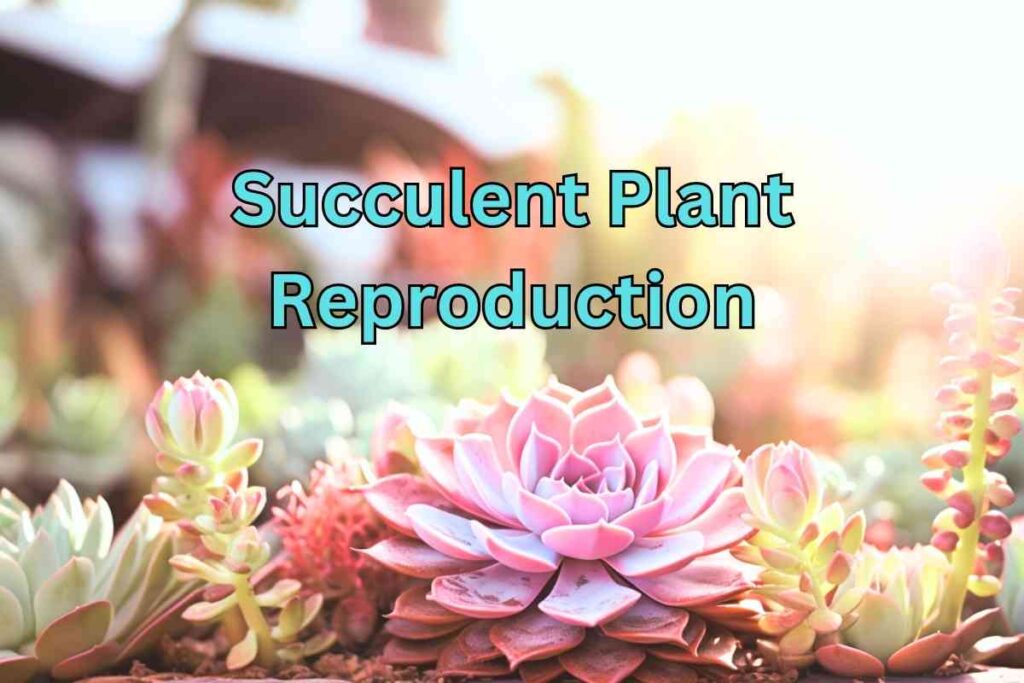
How do succulent plants reproduce?
Succulents can reproduce sexually by producing flowers and seeds or reproduce asexually through vegetative propagation. Offsets or “pups” grow from the base of the parent plant. Leaf and stem cuttings develop roots and form new plants. Bulbils or plantlets grow along leaf margins. Layering methods grow roots before stems are cut from the parent plant.
Let’s explore the many methods of succulent plant reproduction, including propagation from cuttings, leaves, or pups. We’ll also go over the advantages and disadvantages of each method and provide tips for successful propagation.
Whether you’re a seasoned succulent enthusiast or a beginner, understanding the reproductive capabilities of these fascinating plants can help you grow a thriving collection.
Have hanging succulents? Make sure to check out this guide with lots of tips about how to propagate hanging succulents successfully.
If you’ve found your succulent has lost its roots, whether because of trauma, damp soil, or some other reason, this guide will tell you how to save your plant.
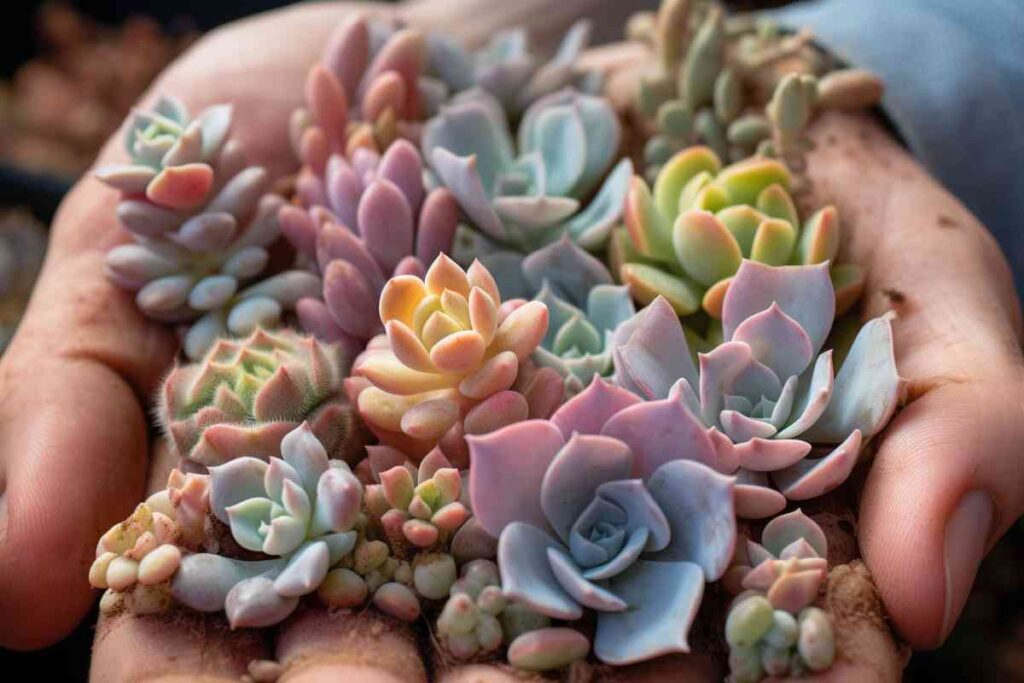
Understanding Succulent Plant Reproduction
Succulent plants can reproduce sexually and asexually, depending on the species and environmental conditions. Sexual reproduction occurs when pollen from one plant fertilizes the ovules of another, resulting in the production of seeds.
Asexual reproduction, on the other hand, involves the growth of new plants from vegetative structures, such as leaves, stems, or roots. This method of reproduction is particularly advantageous in arid environments, where seeds may not be able to germinate due to lack of water.
Sexual Reproduction
Sexual reproduction in succulent plants occurs when the plant is pollinated by another plant, usually with the help of pollinators like bees and other insects. Once pollinated, the plant produces seeds, usually inside a type of fruit.
Succulent plants that reproduce sexually can be grown from seed, but this can be a time-consuming process. It can take several years for a succulent plant to reach maturity from seed.
Asexual Reproduction
Asexual reproduction occurs when the plant reproduces without the genes of another plant. This method of reproduction is common in succulent plants and can be done in several ways:
- Cuttings: Succulent cuttings are a popular method of asexual reproduction. Cuttings are taken from the mother plant and allowed to callus over before being planted in soil. The cutting will eventually grow roots and develop into a new plant.
- Offsets: Some succulent plants produce offsets, which are small plants that grow from the base of the mother plant. These offsets can be removed and planted in their own pot to grow into a new plant.
- Leaf Propagation: Some succulent plants can be propagated from leaves. The leaf is removed from the mother plant and allowed to callus over before being planted in soil. The leaf will eventually grow roots and develop into a new plant.
Asexual reproduction is a faster and more efficient way to propagate succulent plants. It is also a great way to create new plants that are genetically identical to the mother plant.
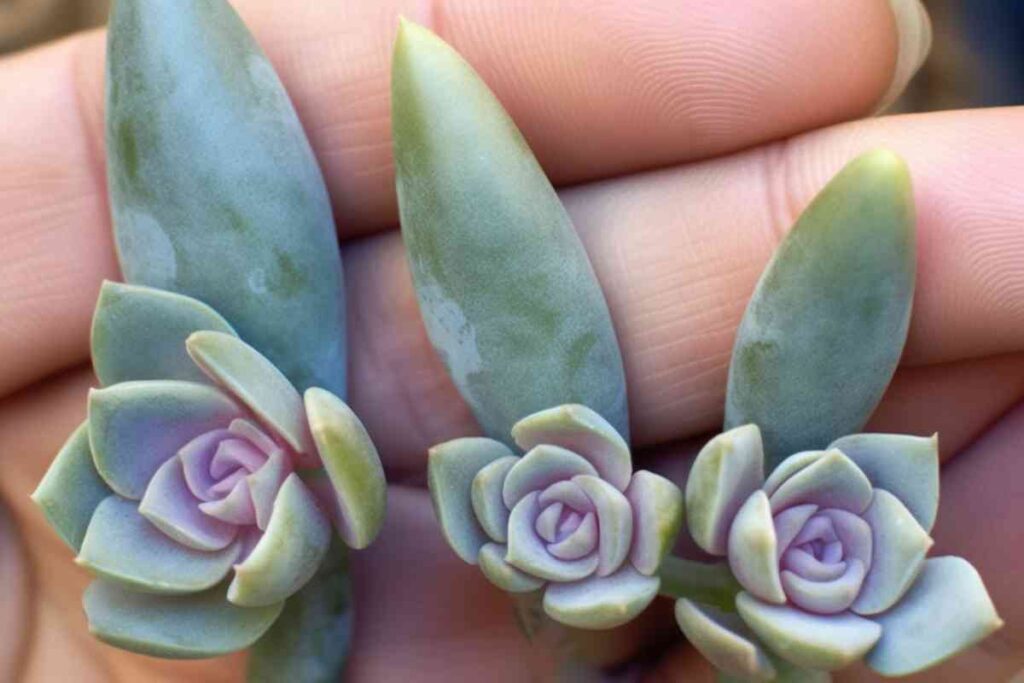
The Process of Propagation
Propagating succulents is a simple and rewarding process that allows you to create new plants from existing ones. There are several methods of propagation, but the most common ones are leaf cuttings, stem cuttings, and offsets.
Leaf Cuttings
Leaf cuttings are a popular method of propagation for succulents that have fleshy leaves. To propagate a succulent using leaf cuttings, follow these steps:
- Gently remove a leaf from the parent plant, making sure to keep the entire leaf intact.
- Allow the leaf to callous over for a few days to prevent rotting. It’s best to wait until you see roots and new leave developing in more humid climates. That’s why I do.
- Prepare a well-draining soil mix and plant the leaf in the soil, burying the bottom of the leaf.
- Place the pot in bright, indirect light. Water thoroughly once new leaves are clearly visible.
- Wait for the leaf to grow roots and a new plant to emerge.
Stem Cuttings
Stem cuttings are a great method of propagation for succulents with well-developed stems and leaves that don’t easily root. Any succulent that can be propagated by leaf cutting can be propagated by stem cutting. To propagate a succulent using stem cuttings, follow these steps:
- Using a sharp, clean blade, cut a stem from the parent plant.
- Allow the stem to callous over for a few days to prevent rotting.
- Prepare a well-draining soil mix and plant the stem cutting in the soil.
- Water the soil lightly and place the pot in a bright, indirect light.
- Wait for the stem cutting to grow roots and a new plant to emerge.
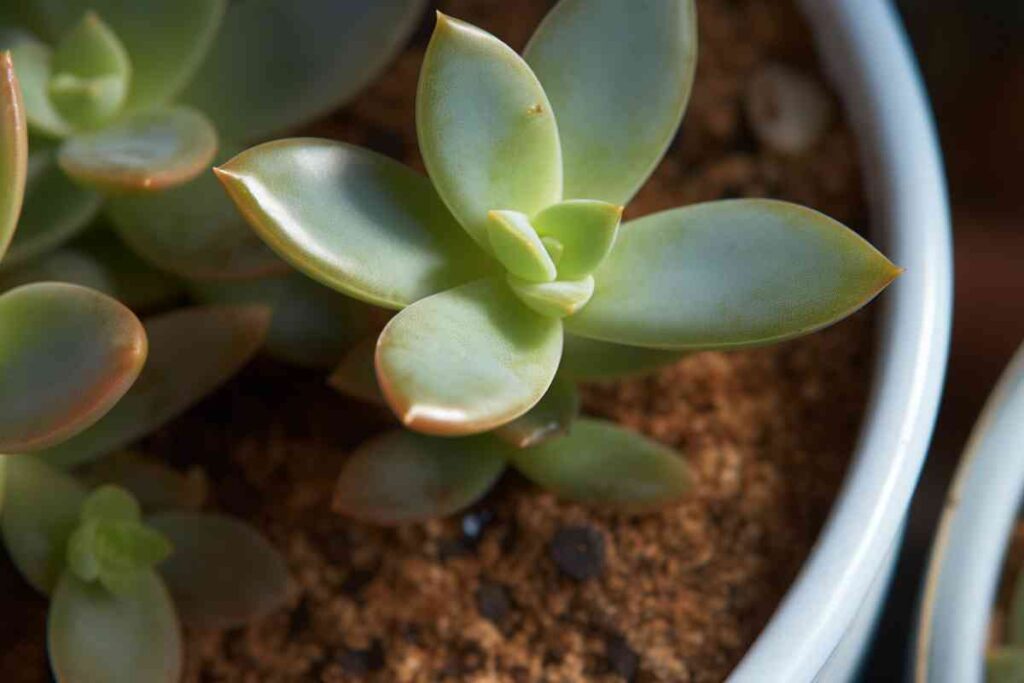
Offsets
Offsets, also known as pups, are small plants that grow from the base of the parent plant. They are a natural method of propagation for many succulent species. Succulents that can’t be propagated by leaf or stem cutting often produce offsets. To propagate a succulent using offsets, follow these steps:
- Gently remove the offset from the parent plant, making sure to keep the entire plant intact.
- Allow the offset to callous over for a few days to prevent rotting.
- Prepare a well-draining soil mix and plant the offset in the soil.
- Water the soil lightly and place the pot in a bright, indirect light.
- Wait for the offset to grow roots and a new plant to emerge.
Seeds
Growing succulents from seed can be an exciting and rewarding experience. Here’s a step-by-step guide on how to grow succulents from seed:
- Prepare the right environment: Succulent seeds require a warm and well-lit environment to germinate successfully. Choose a bright location with indirect sunlight or provide artificial grow lights.
- Choose the right soil mix: Succulents thrive in well-draining soil. Prepare a soil mix by combining potting soil, perlite, and coarse sand in equal parts. This mixture provides good drainage and prevents excess moisture retention.
- Select suitable containers: Use shallow seed trays or small pots with drainage holes. Make sure the containers are clean and sterilized to prevent the growth of harmful pathogens.
- Sow the seeds: Sprinkle the succulent seeds evenly on the soil surface. As succulent seeds are often small, you can mix them with a pinch of fine sand for better distribution. Avoid burying the seeds too deep, as they require light to germinate.
- Lightly cover the seeds: Gently press the seeds into the soil using your finger or a small piece of cardboard. Alternatively, you can lightly sprinkle a thin layer of sand or vermiculite over the seeds.
- Provide adequate moisture: Water the soil gently, ensuring that it is evenly moist but not waterlogged. You can mist the soil with a spray bottle or bottom-water by placing the container in a shallow tray of water for a short period. Avoid overwatering, as it can lead to rot.
- Maintain ideal temperature: Succulent seeds generally prefer warm temperatures for germination. Aim for a consistent temperature range of around 70-75°F (21-24°C). Use a heating mat if necessary to maintain the warmth.
- Be patient: Succulent seeds can have varying germination times. Some may sprout within a few days, while others may take several weeks. Check the soil moisture regularly and avoid disturbing the seeds during this period.
- Provide gentle airflow: Adequate air circulation is important for preventing fungal growth. You can achieve this by placing a small fan nearby or lightly fanning the seed trays for a short duration each day.
- Care for the seedlings: As the seedlings emerge, continue to provide bright, indirect light and maintain appropriate moisture levels. Gradually expose them to longer periods of sunlight to help them acclimate.
- Transplanting: Once the seedlings have developed a few sets of true leaves and are large enough to handle, carefully transplant them into individual pots using a well-draining succulent soil mix. Handle the delicate seedlings by their leaves to avoid damage to the fragile stems.
- Maintain proper care: Place the transplanted succulents in a bright location with indirect sunlight. Water them sparingly, allowing the soil to dry out between waterings. Adjust watering frequency based on the specific needs of each succulent species.
Remember, growing succulents from seed requires patience and attention to detail. It may take time for the seedlings to develop into mature plants, so enjoy the process and celebrate the growth milestones along the way.

Layering
Layering is a propagation method commonly used for succulents that have trailing or vining growth habits. It involves encouraging the stems of the parent plant to produce roots where they come in contact with the soil. Here’s a brief explanation of how to layer succulents:
- Identify a suitable stem: Look for a healthy, flexible stem on the parent plant that can be easily bent and brought into contact with the soil.
- Prepare the soil: Choose a well-draining soil mix, preferably one specifically formulated for succulents. Ensure the soil is moist but not waterlogged.
- Bury a section of the stem: Gently bend a section of the stem towards the soil, ensuring it comes into contact with the soil surface. You can use a small rock or U-shaped wire to hold the stem in place if needed.
- Cover the buried section: Lightly cover the buried section of the stem with soil, leaving the top portion exposed. Press the soil gently to ensure good soil-to-stem contact.
- Provide the right conditions: Place the layered section in a bright, indirect light location. Maintain the soil moisture by watering as needed, ensuring it has time to dry out between waterings.
- Monitor and care for the layered stem: Over time, roots will begin to develop from the buried section of the stem. This can take several weeks to months, depending on the species. Regularly check the soil moisture and adjust watering accordingly.
- Cut and separate: Once roots have sufficiently developed, you can cut the layered stem below the rooted section. Carefully separate the new plant from the parent plant, ensuring you don’t damage the newly formed roots.
- Transplant the new plant: Plant the newly rooted succulent in a separate container or suitable location in the garden, using a well-draining soil mix. Provide appropriate care for the new plant, including adequate light and water.
Breeding Hybrid Succulents
Hybridizing succulents can be a fascinating process that allows you to create unique and visually appealing plant varieties.
- Select parent plants: Choose two succulent plants with desirable traits that you would like to combine in the hybrid. Consider factors such as color, form, size, and growth habits.
- Prepare the parent plants: Ensure that both parent plants are healthy and well-maintained. Remove any dead or diseased parts and provide them with optimal growing conditions to promote flowering.
- Time the flowering: Manipulate the light and temperature conditions to encourage the parent plants to flower at the same time. This synchronization is crucial for successful cross-pollination.
- Pollination: Use a small, fine brush or cotton swab to transfer pollen from the stamen (male reproductive organ) of one parent plant to the stigma (female reproductive organ) of the other parent plant. Alternatively, you can carefully remove the anthers from the stamen of one parent and directly brush them onto the stigma of the other parent.
- Protect the flowers: After pollination, cover the pollinated flowers with a small, breathable bag or netting to prevent accidental cross-pollination from other sources.
- Seed collection: As the flowers start to wither, you’ll notice the development of seed pods. Allow these pods to fully mature and dry on the plant. Once dry, collect the seeds from the pods and store them in a cool, dry place.
- Germination and growth: Sow the collected seeds in a well-draining soil mix and provide appropriate moisture and light conditions. Follow the specific germination requirements for each succulent species, as they may vary. As the seedlings grow, monitor their progress and select the ones that exhibit the desired traits you were aiming for.
- Patience and selection: Succulent hybridization is a long-term process that requires patience and observation. It may take multiple generations of plants to stabilize and fully express the desired traits. Continuously evaluate the seedlings, select the most promising individuals, and propagate them further to develop a stable hybrid line.
Remember, hybridization is a complex process that may require some experimentation and trial and error. However, once you get a unique hybrid, you can create many more using asexual reproduction methods like cuttings.
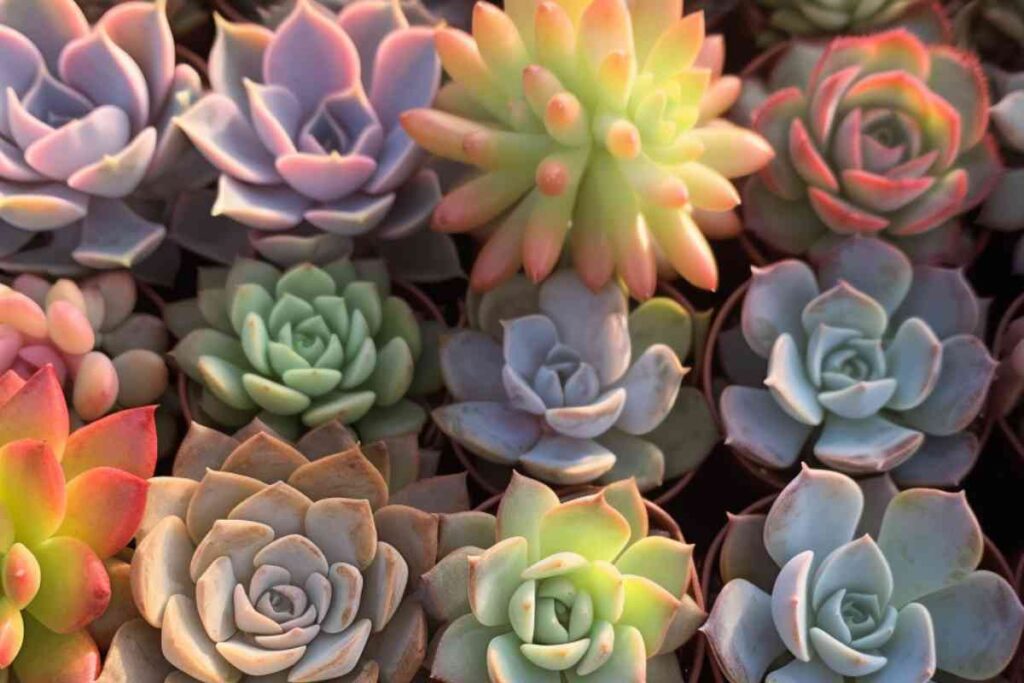
How to Graft Succulents
Grafting may not technically be a reproduction method, but it is a great way to make a unique new succulent. Grafting succulents is a horticultural technique where two different succulent plants are combined to create a single plant.
The process involves joining the stem or tissue of one plant, known as the scion, with the stem or rootstock of another plant. The scion contributes desired traits, such as color or texture, while the rootstock provides a strong and established root system.
- Select the rootstock: Choose a healthy and mature succulent plant that will serve as the rootstock. The rootstock should have a strong and sturdy stem, as it will provide the foundation for the grafted succulent.
- Choose the scion: Select a compatible succulent plant that you want to graft onto the rootstock. The scion is the part of the plant that will be grafted onto the rootstock, contributing its desirable traits such as color, texture, or growth habit.
- Sterilize your tools: Before proceeding, ensure that your grafting tools, such as a sharp knife or scalpel, are clean and sterilized. This helps prevent the transfer of diseases or pathogens between plants.
- Prepare the rootstock: Make a clean and slanting cut across the stem of the rootstock, creating a flat surface. The angle of the cut should match the angle of the scion you will graft onto it. The cut should be smooth and even to facilitate proper contact between the rootstock and scion.
- Prepare the scion: Make a corresponding slanting cut at the base of the scion. Ensure that the cut matches the angle of the rootstock. The scion should be a healthy cutting with a few leaves or stems.
- Grafting: Place the cut surfaces of the scion and rootstock together, aligning them as closely as possible. Press them firmly together to create contact between the cambium layers (the vascular tissue responsible for nutrient transport). You can use grafting clips or rubber bands to hold the scion and rootstock securely in place.
- Provide support: To stabilize the grafted succulent, you can place it in a small pot filled with well-draining soil mix. The soil should provide support for the rootstock while allowing the scion to receive light.
- Create a healing environment: To increase the success rate of the graft, create a moist and humid environment. You can cover the grafted area with a transparent plastic bag or use a humidity dome. This helps retain moisture and promotes the healing process.
- Care for the graft: Place the grafted succulent in a bright but indirect sunlight location. Avoid direct sunlight, as it may stress the grafted plants. Keep the soil lightly moist, but not overly wet, to prevent rotting. Monitor the graft regularly for signs of growth or any issues.
- Patience and observation: Grafting success can vary depending on various factors, including plant compatibility and technique. Be patient and give the graft time to heal and establish. Monitor the progress of the grafted succulent and make adjustments as necessary.
Grafting succulents requires practice and experimentation. It’s important to note that not all succulent species or varieties can be easily grafted due to their different growth habits and compatibility. Start with compatible species and gradually expand your grafting skills. Enjoy the process of creating unique combinations and observing the growth of your grafted succulents!
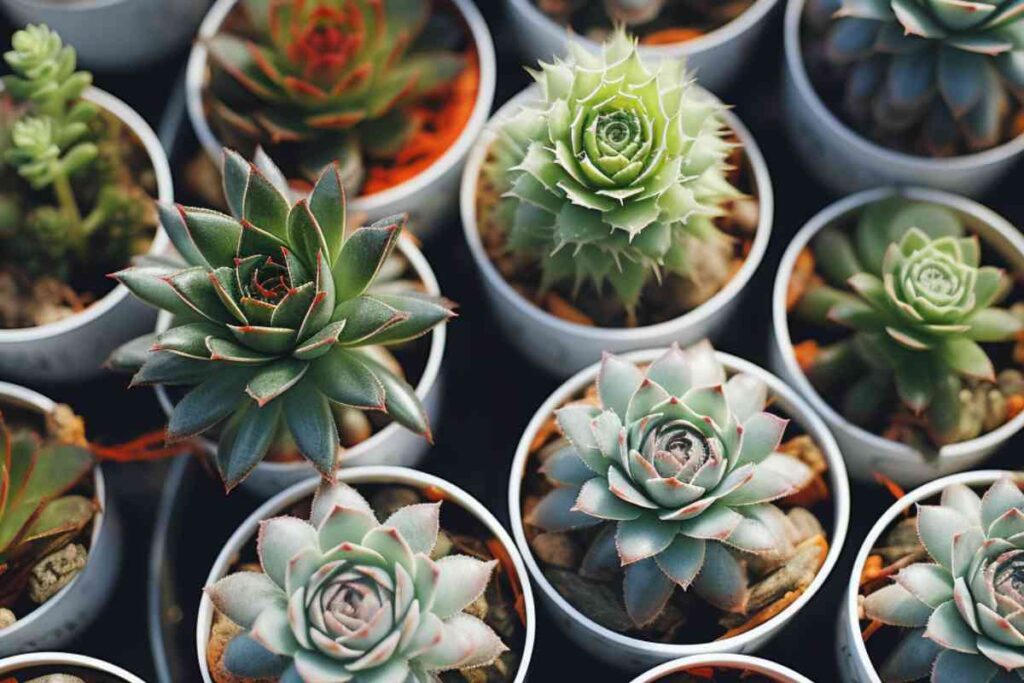
Pollination in Succulents
Bee Pollination
Bees are one of the most common pollinators of succulent plants. They are attracted to the bright colors and sweet nectar of the flowers. When bees land on a flower, they brush against the stamen and pick up pollen grains. As they move on to other flowers, they transfer the pollen to the stigma, which fertilizes the ovule and produces seeds.
Wind Pollination
Some succulent plants rely on wind pollination to reproduce. Wind-pollinated plants do not produce bright flowers or sweet nectar, as they do not need to attract pollinators. Instead, they produce large quantities of lightweight pollen grains that can be carried by the wind for long distances. When the pollen grains land on the stigma of a flower, they fertilize the ovule and produce seeds.
How Long it Takes for Succulents to Grow from Seed Chart
| Succulent Species | Germination Time | Time to Mature Plant | Likelihood of Germination | Likelihood of Maturation |
|---|---|---|---|---|
| Echeveria | 1-2 weeks | 1-2 years | High | High |
| Sedum | 1-3 weeks | 1-2 years | Moderate to High | Moderate to High |
| Crassula | 2-4 weeks | 1-2 years | Moderate to High | Moderate to High |
| Haworthia | 2-4 weeks | 2-3 years | Moderate to High | Moderate to High |
| Lithops | 2-6 weeks | 2-4 years | Low to Moderate | Low to Moderate |
| Aloe | 2-6 weeks | 2-4 years | Low to Moderate | Low to Moderate |
| Sempervivum | 3-5 weeks | 1-2 years | High | High |
| Graptopetalum | 3-6 weeks | 1-2 years | Moderate | Moderate |
| Agave | 4-8 weeks | 4-6 years | Low to Moderate | Low to Moderate |
| Kalanchoe | 4-8 weeks | 1-2 years | Moderate | Moderate |
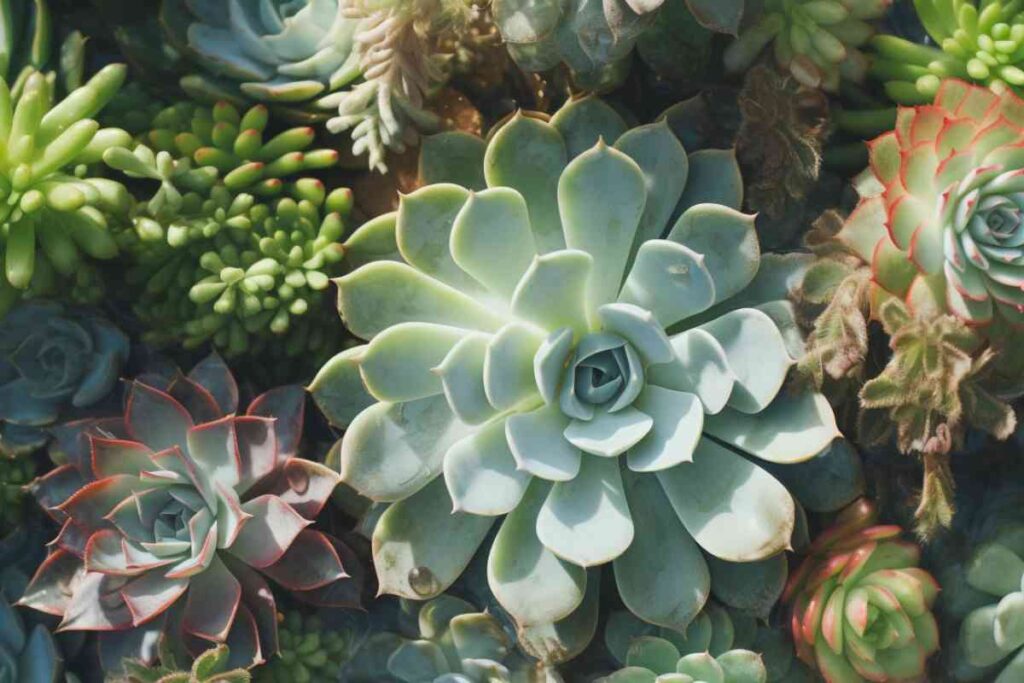
Tools for Succulent Reproduction
When it comes to propagating succulents, having the right tools is essential. It’s not important to choose the most expensive tools or those designed specifically for succulents.
However, it is important that you sanitize all tools thoroughly to avoid passing disease or pests from succulent to succulent. The following are two of the most common tools used for succulent reproduction:
Pruning Shears
Pruning shears are a must-have tool for any succulent gardener. They are used to make clean cuts on heavier succulent stems for successful propagation.
When selecting pruning shears, look for a pair that is sharp, durable, and comfortable to hold. It is also important to keep your pruning shears clean and sharp to prevent the spread of disease.
Scissors
Scissors are another useful tool for propagating succulents. They are particularly useful for making precise cuts on small leaves or stems. When selecting scissors for succulent propagation, look for a pair that is sharp and easy to handle. It is also important to keep your scissors clean and sharp to prevent the spread of disease.
In addition to pruning shears and scissors, there are a few other tools that can be useful for succulent propagation. These include:
- Tweezers: Used to remove leaves or stems from the mother plant without damaging them.
- Chopsticks: Used to create a hole in the soil for the cutting to be planted.
- Spray bottle: Used to mist the soil and cutting to water them without disturbing the young roots.
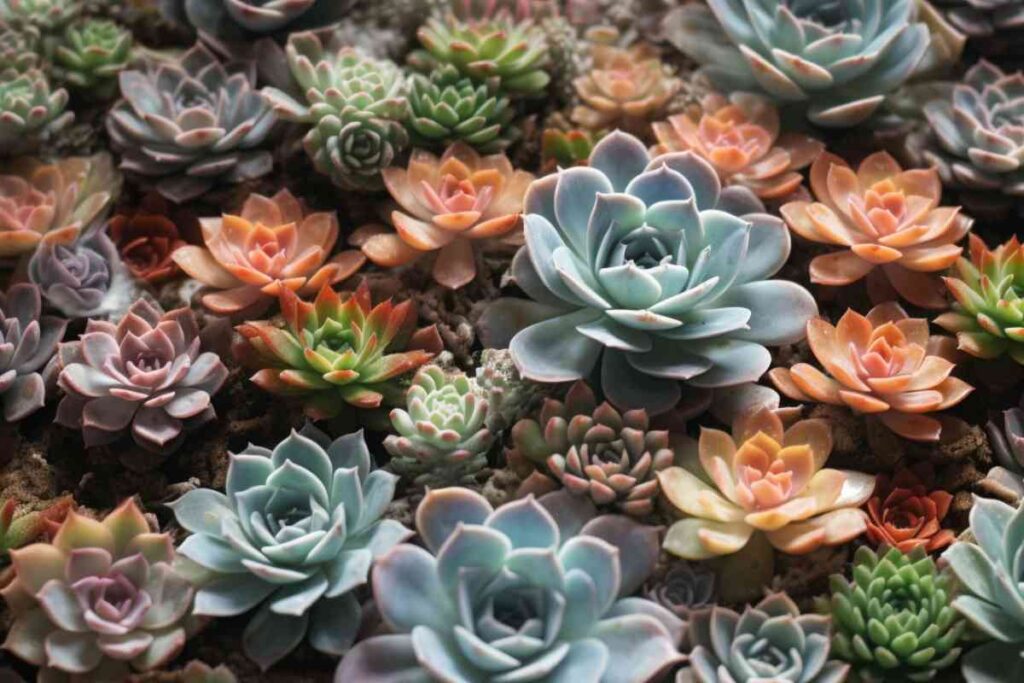
Succulent Species and Their Reproduction Methods
Succulent plants are known for their unique ability to reproduce in a variety of ways. Each species of succulent has its own unique method of reproduction, which can range from stem cuttings to seed germination. In this section, we will explore the various methods of reproduction for some of the most popular succulent species.
Echeveria
Echeveria is a popular succulent species that is known for its rosette-shaped leaves. This species reproduces through stem cuttings, leaf cuttings, and offsets. Stem cuttings are taken from the top of the plant and are allowed to dry for a few days before being planted. Leaf cuttings are taken from the bottom of the plant and are planted directly into the soil. Offsets are small plants that grow from the base of the parent plant and can be removed and planted on their own.
Aloe
Aloe is another popular succulent species that is known for its healing properties. This species reproduces through offsets, which grow from the base of the parent plant and can be removed and planted on their own.
Aloe can also be propagated through stem cuttings, which are taken from the top of the plant and allowed to dry for a few days before being planted.
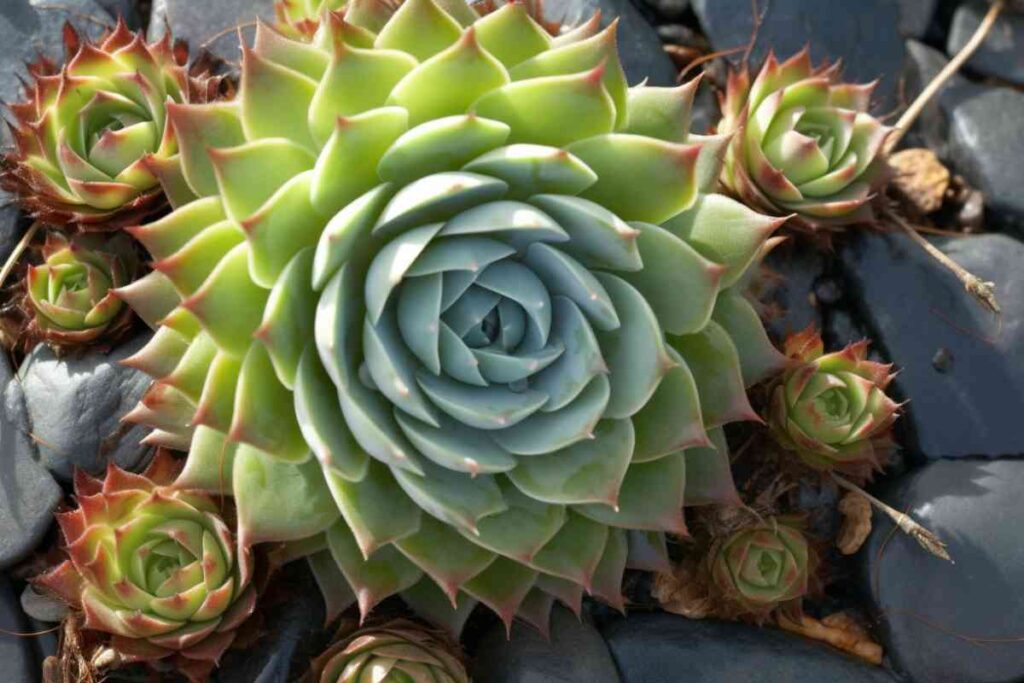
Sedum
Sedum is a diverse genus of succulent plants that includes over 400 species. This species reproduces through stem cuttings, leaf cuttings, and seed germination.
Stem cuttings are taken from the top of the plant and are allowed to dry for a few days before being planted. Leaf cuttings are taken from the bottom of the plant and are planted directly into the soil.
Seed germination can be a bit more challenging and requires a bit more patience, but if you get plenty of seeds and plant them in slightly varied conditions, you’ll probably get some germination from this species.
Agave
Agave is a large genus of succulent plants that includes over 200 species. This species reproduces through offsets, which grow from the base of the parent plant and can be removed and planted on their own.
Agave can also be propagated through seed germination, although this method can be a bit more challenging.
Mammillaria
Mammillaria is a genus of cactus-like succulent plants that includes over 200 species. This species reproduces through offsets, which grow from the base of the parent plant and can be removed and planted on their own.
Mammillaria can also be propagated through stem cuttings, which are taken from the top of the plant and allowed to dry for a few days before being planted.
Kalanchoe
Kalanchoe is a genus of succulent plants that includes over 100 species. This species reproduces through stem cuttings, leaf cuttings, and seed germination.
Stem cuttings are taken from the top of the plant and are allowed to dry for a few days before being planted. Leaf cuttings are taken from the bottom of the plant and are planted directly into the soil.
Mother of Thousands
The Mother of Thousands succulent, scientifically known as Kalanchoe daigremontiana, is a fascinating plant known for its unique method of reproduction. It is native to Madagascar and belongs to the Crassulaceae family.
The Mother of Thousands succulent is a perennial plant that typically grows to about 2-3 feet (60-90 cm) in height. It features thick, fleshy leaves arranged in a rosette formation. The leaves are green and have serrated edges. What sets this succulent apart is its ability to produce tiny plantlets along the edges of its leaves.
The reproductive process of the Mother of Thousands succulent is a form of vegetative propagation called vivipary. Vivipary is the development of new plants directly from the parent plant, usually through modified structures like leaves or stems. In the case of the Mother of Thousands, small plantlets form along the notches or notches on the leaf margins.
These plantlets, also known as bulbils or adventitious plantlets, grow and develop roots while still attached to the parent leaf. Once the plantlets have formed roots and are large enough, they can eventually drop off and take root in the soil, independently establishing themselves as new individual plants.
The Mother of Thousands succulent has become popular among succulent enthusiasts due to its intriguing reproductive strategy and ease of propagation. Some varieties or cultivars of the Mother of Thousands include:
- Kalanchoe daigremontiana ‘Mother of Thousands’: The standard variety with green leaves and the characteristic ability to produce numerous plantlets.
- Kalanchoe daigremontiana ‘Maternity Plant’: A variety with broad, rounded leaves and reddish edges. It also produces numerous plantlets.
- Kalanchoe daigremontiana ‘Chandelier Plant’: This variety has elongated, pendant-like leaves and produces a large number of plantlets, creating a cascading effect.
It’s worth noting that the Mother of Thousands succulent can reproduce prolifically and may become invasive in some regions if not properly controlled. It’s important to consider the potential spread of the plant and manage its growth accordingly.
Jade Plant
Jade Plant, also known as Crassula ovata, is a popular succulent species that is known for its fleshy, oval-shaped leaves. This species reproduces through stem cuttings, leaf cuttings, and offsets.
Stem cuttings are taken from the top of the plant and are allowed to dry for a few days before being planted. Leaf cuttings are taken from the bottom of the plant and are planted directly into the soil. Offsets are small plants that grow from the base of the parent plant and can be removed and planted on their own.
Challenges in Succulent Reproduction
Reproducing succulent plants can be a challenging task for gardeners and plant enthusiasts alike. While succulent plants are generally hardy and easy to care for, their reproduction process can be unpredictable and tricky. In this section, we will explore some of the challenges that come with succulent plant reproduction.
Unpredictable Hybridization
One of the biggest challenges in succulent plant reproduction is the unpredictable nature of hybridization. Hybridization is the process of breeding two different species of plants to create a new hybrid plant with desirable traits.
However, when it comes to succulent plants, hybridization can be a hit or miss process. It is difficult to predict how the offspring of two different succulent species will turn out. Sometimes, the offspring may not have the desired traits or may even be sterile.
If you are using seeds to propagate succulents, you can end up with an accidental hybridization between similar species. If you are deliberately creating hybrids, you’ll have a lot of work ahead of you to create a combination that has the traits you want.
Cultivar Creation
Another challenge in succulent plant reproduction is the creation of cultivars. Cultivars are plants that have been selectively bred for specific traits, such as color, size, or shape. Creating a new cultivar can take years of careful breeding and selection. Additionally, cultivars can be difficult to reproduce consistently. The offspring may not have the same desirable traits as the parent plant, or may even revert back to the traits of the original species.
To overcome these challenges, it is important to have a deep understanding of the genetics and biology of succulent plants. By carefully selecting parent plants and using controlled breeding techniques, it is possible to create new hybrid plants and cultivars with desirable traits. However, it is important to keep in mind that the process can be unpredictable and may require patience and persistence.

Succulents aren’t the fastest growing plants, as a rule. However, if your succulent pups are very slow to grow, you may want to look into proper fertilizing strategies for succulents. Too often, succulent owners are given the bad advice that succulents don’t need fertilizer. They do.
That sunny windowsill may look perfect for propagating succulent cuttings, but be careful. Learn what you need to know about when it’s too hot for succulents.
Frequently Asked Questions
How do succulents reproduce asexually?
Succulents can reproduce asexually through various methods such as offsets, leaf cuttings, and stem cuttings. Offsets, or pups, are small plants that grow from the base of the mother plant or from the leaves still on the plant.
Leaf cuttings is taking a leaf from the plant and allowing it to root and grow into a new plant. Stem cuttings does the same but with a stem.
How do succulents reproduce sexually?
Succulents can reproduce sexually through pollination. Pollination occurs when the male reproductive cells of a plant combine with the female reproductive cells of another plant to create a new plant. This can happen naturally through insects or wind, or it can be done manually by a gardener.
What type of reproduction do succulents have?
Succulents have both asexual and sexual reproduction methods. Asexual reproduction involves creating a new plant without the need for pollination, while sexual reproduction involves creating a new plant through pollination.
Can you reproduce succulents?
Yes, succulents can be reproduced through various methods such as offsets, leaf cuttings, stem cuttings, and pups. Each method has its own specific requirements and success rates, but with proper care and attention, new plants can be successfully grown.
How fast do succulents reproduce?
The speed at which succulents reproduce depends on various factors such as the type of succulent, the method of reproduction, and environmental conditions. Some succulents can reproduce quickly and produce new plants within weeks, while others may take several months or even years to produce new plants.
What is the timeline for succulent leaf propagation?
The timeline for succulent leaf propagation varies depending on the type of succulent and environmental conditions. Generally, it takes several weeks to several months for a leaf cutting to root and produce a new plant. During this time, it is important to provide the cutting with proper care and attention to ensure its success.
Succulents can reproduce asexually through various methods such as offsets, leaf cuttings, stem cuttings, and pups. Offsets are small plants that grow from the base of the mother plant, while leaf cuttings involve taking a leaf from the plant and allowing it to root and grow into a new plant. Stem cuttings involve taking a stem from the plant and allowing it to root and grow into a new plant, while pups are small plants that grow from the base of the plant.
“}},{“@type”:”Question”,”name”:”How do succulents reproduce sexually?”,”acceptedAnswer”:{“@type”:”Answer”,”text”:”
Succulents can reproduce sexually through pollination. Pollination occurs when the male reproductive cells of a plant combine with the female reproductive cells of another plant to create a new plant. This can happen naturally through insects or wind, or it can be done manually by a gardener.
“}},{“@type”:”Question”,”name”:”What type of reproduction do succulents have?”,”acceptedAnswer”:{“@type”:”Answer”,”text”:”
Succulents have both asexual and sexual reproduction methods. Asexual reproduction involves creating a new plant without the need for pollination, while sexual reproduction involves creating a new plant through pollination.
“}},{“@type”:”Question”,”name”:”Can you reproduce succulents?”,”acceptedAnswer”:{“@type”:”Answer”,”text”:”
Yes, succulents can be reproduced through various methods such as offsets, leaf cuttings, stem cuttings, and pups. Each method has its own specific requirements and success rates, but with proper care and attention, new plants can be successfully grown.
“}},{“@type”:”Question”,”name”:”How fast do succulents reproduce?”,”acceptedAnswer”:{“@type”:”Answer”,”text”:”
The speed at which succulents reproduce depends on various factors such as the type of succulent, the method of reproduction, and environmental conditions. Some succulents can reproduce quickly and produce new plants within weeks, while others may take several months or even years to produce new plants.
“}},{“@type”:”Question”,”name”:”What is the timeline for succulent leaf propagation?”,”acceptedAnswer”:{“@type”:”Answer”,”text”:”
The timeline for succulent leaf propagation varies depending on the type of succulent and environmental conditions. Generally, it takes several weeks to several months for a leaf cutting to root and produce a new plant. During this time, it is important to provide the cutting with proper care and attention to ensure its success.
“}}]}




